|
M. FORD CREECH ANTIQUES & FINE ARTS
www.mfordcreech.com
THE SEASON of
LIGHT
&
REFLECTION(S)

Marco Polo (of old)
Did chance 'pon 'white gold'*
When visiting China's fine treasures.
Once home, on a beach,
Saw a 'shell' within reach,
And recounted its likeness, by measures :
"White, Shiny! Smooth, Rounded!"
His voice it resounded!
But the name - it confounded :
'Porcellanas'!....
(In Italian, 'mama pigs',
Rounded backs - bellies big!
Coiled tails – and 'more' similarities.)
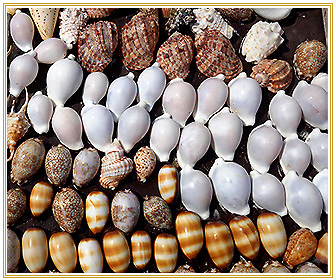
And still til this day
When 'porcelain' we say
We refer to the white pigs, that were Italy’s.
(But Watch!...)
As the 'lustre' of ‘old Polo's’ porcelains
Banishes the chills of fall's misty rains
With reflections so bright
They whisk away night
And even make candles shine twice again :
'PORCELLANAS' !
( PORCELAIN ! )
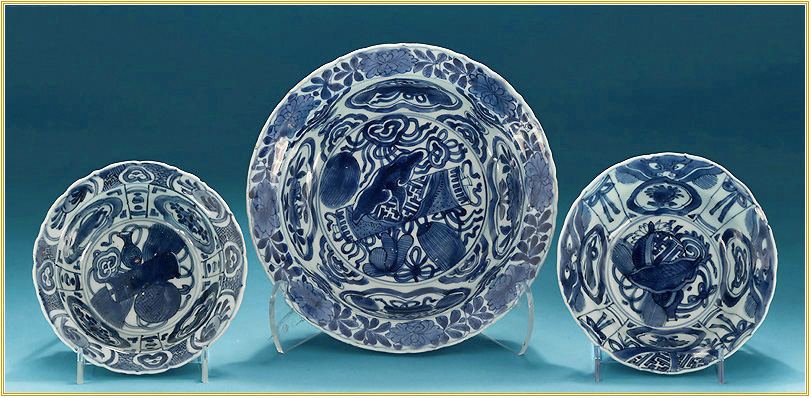
Three Ming Dynasty ’'Kraak' Blue & White Porcelain 'Klapmutsen'
China, c1600-1620
Each Centering "Auspicious Symbols",
and having deep rich color beneath a fine "reflective" glaze
Left : Rinaldi Group IV, 5.75" Wide
Center : Rinaldi Group II, the cavetto with rare opposing Ruyi Scepters, 8.25" Wide
Right : Rinaldi Group V, with 'Taotie' Masks, 6" Wide
The terms "Kraak" and "Kraakware" refer to the late 16th and early 17th century
Chinese Ming blue-and-white porcelain, made for export to the West.
The term came about after the 1603 Dutch capture of 2 Portuguese "carracks"
(sailing vessels) and 200,000+ pieces of glistening Ming porcelain -
the word "carrack" in Dutch becoming "kraak".

Kangxi Blue & White Porcelain Peacock Charger
Painted in the Ming Style, China, 1690-1722
Richly painted,
the eight large central flower-filled petals reserved on a trellis-diapered ground,
the rim with four peach basket cartouches reserved against richly decorated panels
of long-tailed peacocks, within chrysanthemum heads and scrolls.
This combination wishes wealth, nobility and longevity
(A similar large dish is illustrated in "Chinese Ceramics", He Li, p. 288;
In the V&A Museum Collection, museum number : C.792-1910;
And a pair in the Asian Art Museum, San Francisco, Avery Brundage Collection)
15-3/8" Wide
Many consider the Kangxi period to be the height of blue and white painting,
with a glassy "reflective" glaze resembling melted sugar.
Both Ming and Kangxi blue and white porcelains were
favorite subjects for 16th and 17th century Dutch painters
as the still life below, from Workshop of Jan Van Kesse,
picturing four kraak klapmutsen (bowls) and a dish. Antwerp 1626-1679.
One can only imagine the radiant beauty these surfaces must have brought,
into the dark candlelit rooms of the 16th and 17th centuries.
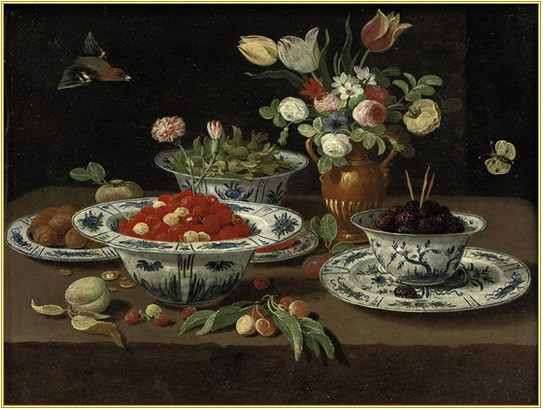
Imported into Europe, along with the porcelain was tea - and with it, teawares.
Tea drinking in China dates to c600 AD, reaching Holland about 1610 via the Dutch East India kraaks,
and imported into England in the 1650s, by way of the British East India Company.
In 1660, diarist Samuel Pepys, visiting with dignitaries in a London coffee house,
wrote in his diary about
"a Cupp of Tee (a China drink) of which I never had drank before" -
seeming totally unsure of what it was or how to spell it.
In 1660, tea was only the wealthy man's drink -
a pound of tea being equivalent in value to 1440 bottles of sherry!
Thus the accompanying teawares were often quite small!
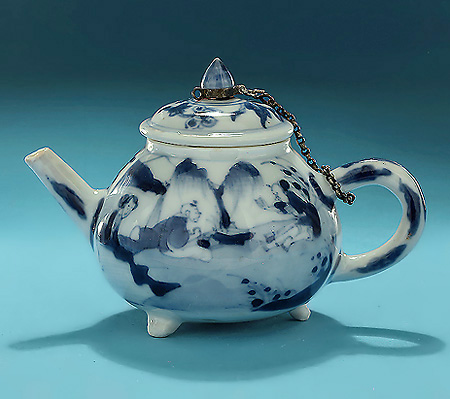
Rare Kangxi Blue & White TripodTeapot, China c1662-1690
Painted with Chinese figures in a garden before mountains,
the reverse with three geese on a riverbank;
Raised on three splay feet, and only 3.25" High
Kangxi Blue and White porcelain (and teapots) coming into Holland were often enhanced for European tastes.
“Enhancements” included both silver mounts and painted with gilt for even more shine.
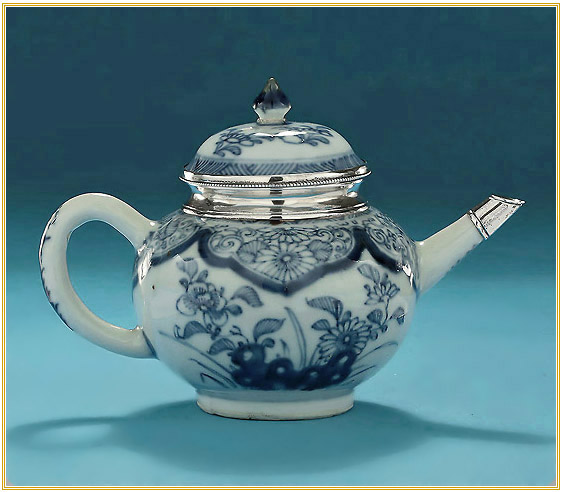
Yongzheng Silver-Mounted Blue and White Teapot
c1722-35, China, The Marked Silver Mounts Dutch
The bordered lappet shoulders with flowers above further flowers and grasses below;
The collar and cover with beaded "silver" mounts / 4.8" High
As well as their teapots, the Dutch (in particular) added reflective silver mounts to other
tea "equipage" - as tea caddies and milk jugs - in fact, to all manner of Chinese "porcellanas".
Whilst the earliest known metal mount is to a c1618 covered Wan Li bowl,
most silver enhancements were added in the 18th and 19th centuries.
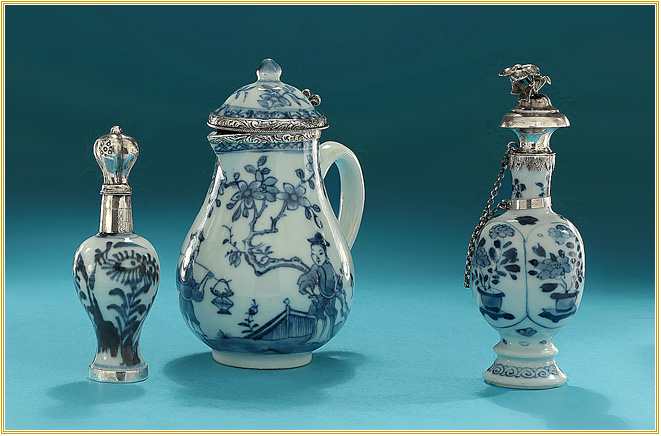
.Left to Right :
Kangxi Silver-Mounted Scent Bottle, c1700, with original interior silver-mounted stopper
Kangxi Blue & White Silver-Mounted Tea Caddy, c1680-1700, Dutch Mounts, Hendrik Frederik Koen
Kangxi / Yongzheng Blue & White Silver-Mounted Lidded Jug, c1680-1730, Dutch, Mounts Jacob Helweg
The Chinese teapot below was enameled in The Netherlands in the Dutch doré manner,
and known as "Basket of Flowers and Fisherman" decoration.
The same scene decorated a small bowl also shown below -
a late 1727 purchase by Augustus the Strong for his collection
later known as the Japanese Palace, and pictured
Helen Espir, "European Decoration on Chinese Porcelain" :
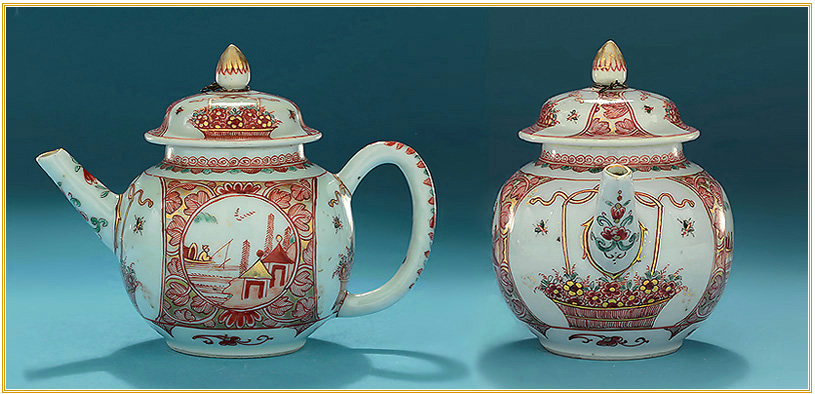
Dutch Painted Chinese Export Teapot
Yongzheng, Early 18th Century
Painted with roundels of a Chinese fisherman in a riverscape alternating with a basket of flowers,
on an iron-red leaf and "luminous Dutch doré" ground / 5.2" High
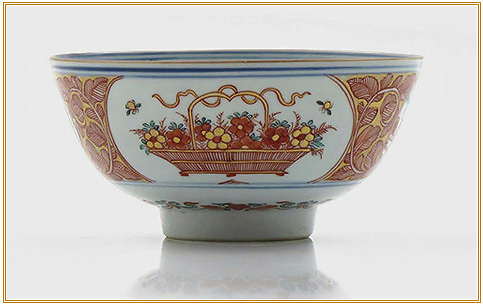
This bowl’s underside with an incised and colored 'Johanneum' mark for the
Dresden Japanese Palace Inventory 'N+113', and an upwards pointing arrow;
purchased in late 1727 / 5.8" Wide (The Bowl, a Private Collection)
Although most of Europe sought to find the secret to this "white gold",
for England, clearly, Samuel Pepys "cupp of tee" was the inspiration.
Needed was a material rivaling Marco Polo's
"porcellana" (hard, white and shiny!),
so that the very hot water needed for tea would not burst the teapot.
After numerous attempts and combinations, a banker / grocer and a coal-miner
came up with a one of the most successful early formulas - "soaprock" added to the clay.
This company was Worcester, and the combination produced a porcelain-like material
somewhat similar in both appearance and function to Chinese porcelain -
thereby forever! "lighting up" British lives with "tee".
For a great while, British wares were even painted with Chinese motifs and scenes.
Below is such a Worcester teapot, appropriately named - "Chinese Family".
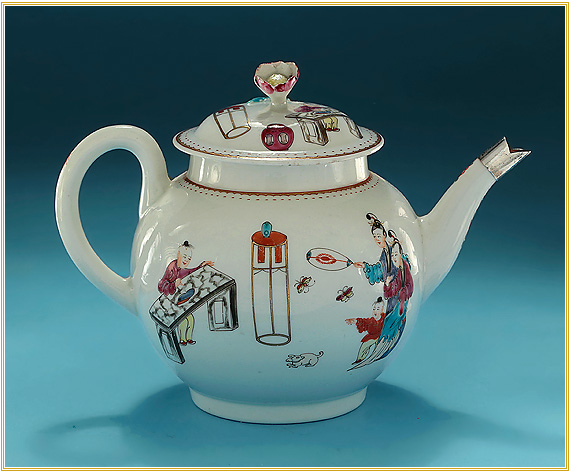
First Period Worcester Soft Paste Teapot
England, c1760-65
Meticulously enameled and heightened with gilt
in the "Chinese Family" / 5.5" High
And enhanced with a "shiny silver tip" to protect a minute spout nick
Throughout the 18th century, European nations continued to develop their own porcelains.
Although beginning by imitation of Asian decorations, slowly each evolved into their individual styles -
discernable even if remnants of Chinese decoration remained.
"Chelsea" was another early English manufactory,
and quick to develop European forms and decoration,
this dish after a mid-18th century European rococo "silver" shape :
Chelsea "Silver-Moulded"Polychrome Dish
London, c1752-54 / 11" Wide
Decorated with scattered fruit and insects – but distinctly British.
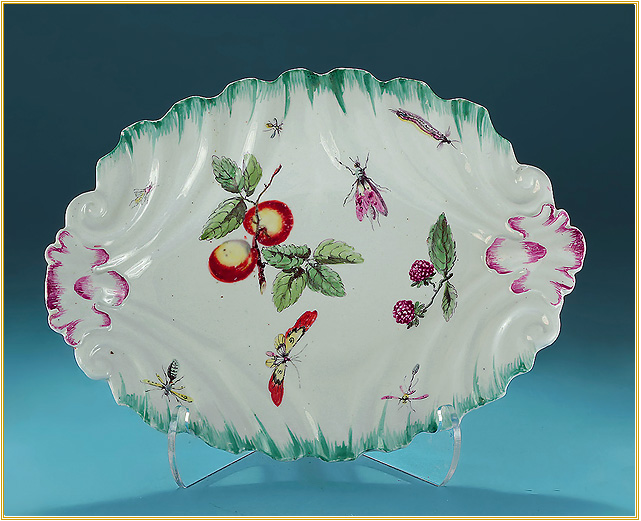
And a
First Period Worcester "Sir Joshua Reynolds" Deep Dish
England, c1770-72 / 8.5" Diameter
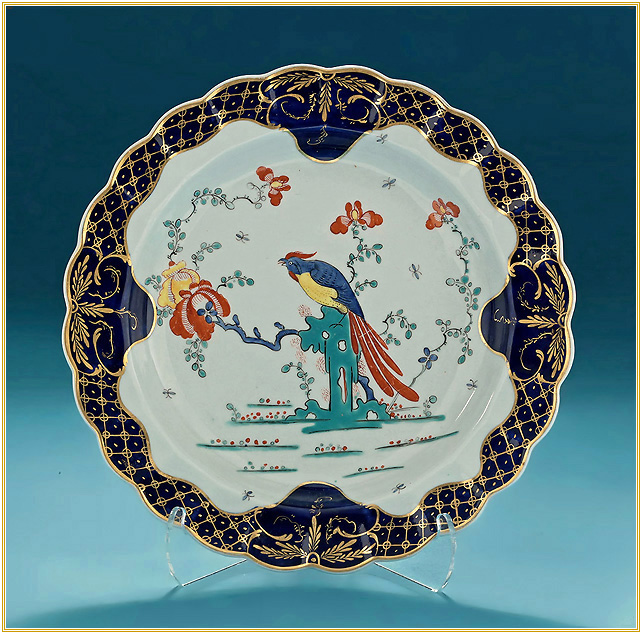
In extraordinary condition, and inspired by 17th century Japanese Kakiemon palette and design,
yet distinctly British, with an intricately "shining gilt-enhanced" wet-blue border.
So named as the noted British painter, Sir Joshua Reynolds, is said to have owned a set.
Compelled by Marco Polo’s mysterious "porcellanas", and the arduously imported early "white gold",
most 18th century European countries attempted - and succeeded - in making their own porcelains.
By the late 1700s, the "industry" of European (and later American) porcelains was well underway -
very likely parenting the porcelains on your own Holiday table.
However those early mysterious "porcellanas" who still remain...still serve,
though maybe not the Christmas "roast goose"!
They recall for us curious images of life in another time,
"enlighten" and enrich our lives in this highly mechanized world,
and hopefully live to speak to the many generations ahead
of their continued existence - despite their "fragility".
May a star light your candle
Your robes keep you warm
May the oven feed your hunger
Your joy know no harm
May your friends be around you
Your pet at your feet
At this year's Christmas table
Around which -
we truly hope to meet.
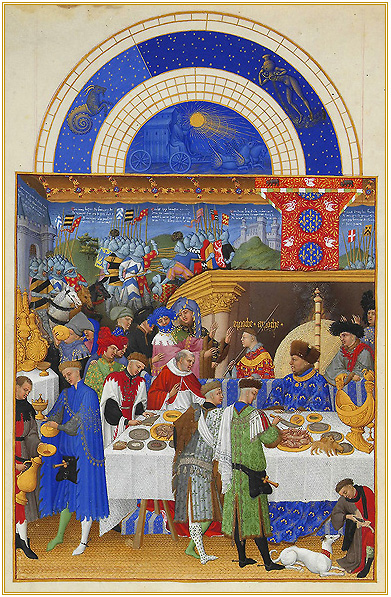
Legend :
"Marco Polo
Travels with Kubla Kahn",
"Livre des merveilles et autres récits de voyages et de textes sur l'Orient"
(Book of Wonders and Other Travels and Texts on the Orient),
an illuminated manuscript produced in France around 1410-1412.
The collection included illuminations and several texts evoking the Orient
gathered and painted for the attention of Jean sans Peur, Duke of Burgundy,
containing the 'Devisement of the World' by Marco Polo (as well other texts).
Bibliothèque Nationale, fr. 2810, fol. 42v. (Gallica Digital Library)
*"White Gold" : In 1271, Marco Polo departed Italy toward China, via both sea, and the Silk Road
He returned in 1292, writing a book on his travels and discoveries, including the mysterious porcelain.
However Chinese porcelain was not" imported" into Europe until the late 1400s.
It was at first the coveted material of royalty,
considered the equivalent to gold - and often being called "white gold".
Unlike European soft and low-fired pottery,
high-fired porcelain, with its beautiful decoration and fine glazes,
was light, often thin, hard, lustrous, rang like a bell, and could withstand high temperatures.
Its composition remained a tantalizing and sought-after mystery for several hundred years.
And even through the 1600s, should you wish to give royalty - or the Pope - a fine gift,
that gift might indeed be Chinese porcelain.
"Cowry and other Indian Ocean shells in Zanzibar", EQRoy, Alamy (by Lease)
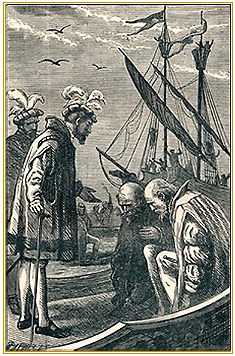
"Porcellanas" :
In 1497, Portugal’s rather enthusiastic King Manuel I (above) instructed Vasco da Gama,
on departure of his famous first exploratory voyage to "India" (the Orient),
to bring back "porcellanas".... along with some spices and Christians ....
As well, early porcelain became known as "Chinawares", due to their origin - China.
"Très Riches Heures du Duc de Berry",Herman, Paul and Jean de Limbourg, c1410.
John, Duke of Berry enjoying a grand meal, the Duke sitting at the high table surrounded by numerous guests,
servants and his hound. Tempera on Vellum. Condé Museum, Paris
Also known as Jean de Berry, the Duke was an avid sponsor of the arts and collector,
possessing one of the earliest pieces of Chinese porcelain entering Europe :
the richly moulded Fonthill vase, c1300-1340, the silver ewer mounts later (a 1713 watercolor).

(Now with mounts removed and in the National Museum of Ireland.)
Inventory
Photography : Millicent F. Creech
Please Visit Our Other 2020 Christmas Catalogs :
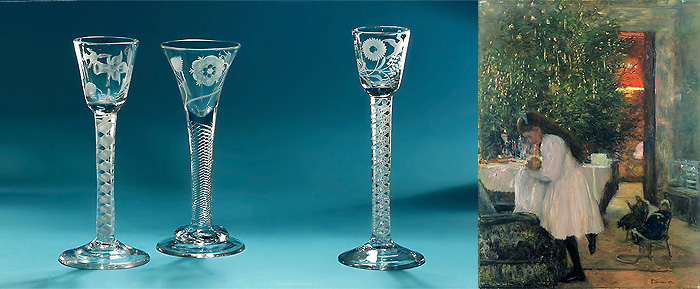
THE SEASON of LIGHT & REFLECTION(S) : GLASS!

THE SEASON of LIGHT & REFLECTION(S) : SILVER!
|